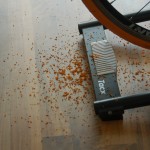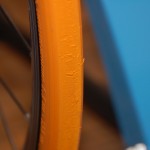I picked up one of these from Starbike recently. Firstly, Tacx really need to get some better instructions. The ones that come with the unit are crap, and that is putting it lightly. There is no mention of how much to tighten the clamp on the wheel and it took some google time to figure it out. (In my case, pretty much as tight as possible to stop things slipping, then do the calibration).
Trainer VS. Cycling
The difference between using the trainer and normal cycling is astounding. I suppose seeing constant references to sweat bands, sweat mats, sweat catchers etc should have come as a bit of a hint but nothing could have prepared me for the experience. For my last run on the trainer I did a 20.4km virtual course taking around 40 minutes. For this I went through 1 full bottle of water and then downed a further two pints of juice inside of 5 minutes off the bike. Compare that to yesterday when a 120km trip on the bike only required 2 bottles with another half afterwards.
It isn’t like the trainer is physically harder either. Ok so the (virtual) hills can be bigger than those in real life, but the big thing comes from the fact that you don’t coast along at any point. Even the downhill requires you to continue to pedal or it pauses. And because you are pedalling, you are pushing out effort unlike in reallife where down hills tend to be a bit of a relaxing time / recovery time. The huge difference is airflow however. It makes a gigantic difference when on the bike compared to cycling indoors. On days where you warm up in five minutes outside and stop feeling some of the cold, you’ll warm up in about 10-20 seconds on the bike. In my case, I was already visibly sweating inside of a minute.
A Bright Orange
If you are questioning if the trainer tyre might be a good purchase or not, then stop right now. The trainer will eat even the toughest of road tyres. The trainer tyres are made of some different kind of rubber that doesn’t heat up and is slightly slippy. But even the trainer tyre still gets shredded a bike while on the trainer. I can only imagine what would happen with a proper grippy tyre and that is without thinking about those tiny bits of glass that get embedded in the rubber for cycling on the road. Even now after a few weeks, each run still leaves specs of rubber spread around the floor.
Edit: So the tyre wore out within 12 rides I think. Something can’t be right. Some pictures.
Software
This is actually one area where I’ve a bone to pick witht Tacx. My unit being a Fortius, it obviously came with the Fortius software. However it is quite hard to understand the different software versions online. There is another Tacx Trainer software which is supports the Google Maps setup and some extra Catalyst functions but it requires an extra purchase. For those on lower trainers, there is little notice on if they need to purchase the Fortius software and then the additional trainer software.
I’ve yet to use too much of the features on the Fortius software mainly sticking with the Real Life Videos so far, so maybe after I get through the Alpine course of the Marmotte run I’ll look into getting the other software. It still is a bit rich of Tacx to have so many paid extras like this. But then everything after the initial purchase seems to be extra.
Annoyingly however, the software was one of the reasons I choose the Fortius over the new Bushido wireless trainer. The motor to simulate downhills in the Fortius isn’t really any use if we are being honest. Since you always need to push somewhat, the Bushido could just reduce the resistance right down to whatever it needs to stay active. The lack of wireless would also be quite a good thing. Right now a Bushido with the computer link and the additional software would set you back a bit more than the Fortius although since Tacx are pushing the Bushido, that may change.
There have been a few reports of the video not going to full screen too. Luckily I have only seen this once when I launched the VR terrain the very first time. The next two times it went full screen. Never had any issues with the RLV except that they are standard aspect where as my laptop is Widescreen. Minor really. The Tacx VR Game Crazy Cycles is another story though. It sits in a small window with a black border. Attempts to do anything on screen to full screen it cause it to minimise.
A Wheel Stand as a Prop
“Should I buy the wheel stand?” was one of the most asked questions I got after talking about the trainer to other who wanted to get one too. My initial answer of yes, you need to level the bike, and no you can easily use cardboard or similar has changed somewhat now. I know one of the guys who bought around the same time as me has had no problems while using an Argos Catalogue, while I have been using some cardboard piled under the front wheel. I’ve yet to manage to have the bike still be level at the end of a long ride, probably because the cardboard compresses somewhat under my weight.
I’ll leave the decision up to the reader on this one.
Some little bitty gotchas
These most likely apply to other trainers in the Tacx range too.
- For your profile weight, enter your fully clothed weight *AND* the weight of your bike.
In my case (using current rounded figures), I weight 90kg and my bike weights 13kg fully loaded. Profile weight goes in as 113kg. The extra KG from the bike do affect the resistance that the unit puts out of the hills.
- Do the calibration, but only after about 30 minutes of cycling the first time.
Again in my case, I got a different of -3.1% which was noticeable enough on the 12% hills that were in the RLV.
- Tighten the wheel clamp and ensure the tyre is pumped fully. A vertically true wheel will also make a huge difference.
Because the whole system works with resistance against the tyre, any let up in pressure is going to feel like slipping. Not something you might notice at 110RPM on a fast flat part, but slow that down to 70RPM on a steep uphill, and well it’ll be damn near unusable.
- Towels, towels and more towels.
You will sweat. A lot. A whole hell of a lot. I’m sure a fan will help and I plan on getting one soon.
Heart Rate Monitoring
The Fortius is *NOT* ANT+ compatible. I’m nearly sure a software upgrade would fix this too. The Bushido is compatible so it shouldn’t require extra work on the part of Tacx either. Because of the cost of changing the units, it is highly unlikely that anyone would actually switch units to get a missing feature like this. So Tacx, add the feature.
Online reports list than a standard non-coded strap will work. All the Garmin ones are ANT+ so the one I have doesn’t work. The cheap Aldi one I bought recently doesn’t work either. Don’t fancy buying a third one just to see if it works.
Real Life Videos
These are the reason I choose a Tacx trainer and not some other brand. They rock. Makes training so much better. I know well that I’d not be able sit for an hour and a half grinding up a hill like the other night without being able to look forward and see the views of the Alps.
There is some minor issues with the videos. For one, they aren’t recorded in a constant fashion. Tacx did do some work to try smooth over things. One example is where the van had to stop at traffic lights in one of the villages. The video blends in the slowing down and starting back up again so you aren’t pedalling while the video isn’t moving. They also blend where it pulled in on the way up one of the larger hills.
I have heard people saying the video gets a bit jumpy if you go too slow. I’ve yet to see this although the video did start shooting forwarding much faster than reality on one of the downhill sections. Throws you off balance somewhat.
Last bit is that the shadow of the camera is visible in quite a while of the videos. Does drop the appearance that you are actually cycling the route some what but I guess it is just a video and not a VR setup.
Summary Round Up
Would I buy one? Well I do so yes. Would I recommend you buy one? Well maybe. It depends on what you are after. The Bushido does look like a better, but somewhat more expensive option due to the extras you need to get it to do certain things. However since the prices vary hugely on these (Got my Fortius for €660 while initially seeing if for close to 1000 in a local shop) I’d guess you may be able to get a deal on the Bushido. Reports so far say the Bushido can produce the same amount of resistance as the Fortius, it may not be an issue. A 10% grade for me uses less than half the resistance the Fortius can push out so unless your much heavier and planning on harder hills, you’ll be fine.
Since I’ve seeing the Bushido for €560 on eBay, if I was to buy today (only a month later) I’d go for the Bushido and the upgrade PC kit. I do blame Tacx for this as the Bushido was out when I purchased. I didn’t think I’d need to but extra software for the Fortius which is quite annoying.
Edit: Tacx have released yet another version of software. Trainer software Version 2. They did offer an upgrade from V1 to V2, but they stopped on December 15th. Huge pain but I’m quite glad I didn’t fork out for V1 when I was planning to. Make sure if you are buying that you are getting the Trainer software Version 2 with the unit, not just the Fortius software which is long since obsolete.
http://www.starbike.com/php/product_info.php?lang=en&pid=6272









